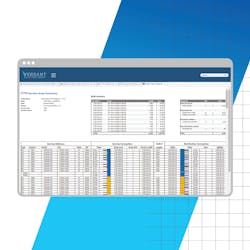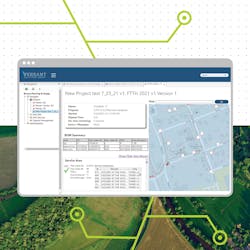Automated Design and Optimization (ADO) Can Help Prep Your Network
Today’s digital world has provided us with the tools to bring all industries into the next generation, where artificial intelligence (AI), virtual reality (VR), and other innovations will create an immersive digital metaverse. But before we get there, network operators and service providers need to build and upgrade their broadband networks to withstand the test of time and support the bandwidth-intensive applications of today and tomorrow.
That can be a tall task, especially as several new types of broadband providers enter the industry every day and established carriers embark on the transition from cable or copper legacy systems to future-ready fiber. The signs of this change are everywhere, with AT&T openly talking about the “Copper Sunset” and Altice replacing much of its U.S. network with fiber to support the 10 Gbps and beyond symmetrical speeds that users demand.
In fact, ADO proved to be a vital approach for planning and deploying a new network architecture across the (cable) company’s entire footprint. It helped shrink its existing RF plant by replacing it with fiber. The data also kept investors, franchise authorities, and vendors informed about the company’s network upgrade strategy.
Some are embracing the latest network software design tools for a more efficient and easier way of building and managing their networks to keep up with demand and inevitable upgrades. ADO software features a “network in a bag” approach that documents all network elements, providing engineers the ability to optimize the existing plant before incorporating new features and expanding coverage beyond existing boundaries.
Until recently, network planning has been done in a manual or semi-manual fashion, with cost estimates generated by spreadsheets for a small portion of the overall coverage footprint and then extrapolated across the entire build plan. As a result, cost figures for greenfield projects are overestimated by a significant amount to ensure there are no material shortages, which introduces a high level of uncertainty in the budgeting process.
Why ADO?
The right software provides a computer-aided approach to network design, accelerating the process from weeks and months to mere minutes or hours. Using a service provider’s rules and equipment specifications, the technology provides the ability to generate network designs with optimal routing of fiber and integration with existing plant engineering platforms as needed. Automating the process by creating a digital twin of the entire network delivers significant savings of time and cost when compared to legacy manual planning and design methods.
Rapid creation of a virtual network design is the starting point for network engineers, enabling them to generate alternatives to examine the use of different network elements, architectures, and coverages. Want to look at upgrading a network segment from GPON to XG-PON? Point and click. Since less time is spent on manual plotting and estimation of one specific model, more time can be invested in examining options for the best network design that fits the operator’s philosophy and current and future customer needs.
Once the best overall design is selected, it can be fine-tuned with the model used to generate plans and cost estimates with more accuracy than a manually generated network proposal. A few more clicks create a solid cost estimate and generate a bill of materials with the ability to export the data out to other platforms for use by acquisitions and billing.
This provides a much higher level of certainty in project costs. Since the entire network footprint is calculated in the final design run rather than a small sample calculated manually and extrapolated as a cost estimate to the entire network, cost estimates and bill of materials are much more accurate. While there will always be some changes during field validation and testing, the overall degree of change and uncertainty in build and materials costs is significantly less than manually generated design and cost models.
Network Expansion Aid
Service providers need to continually examine their networks to improve bandwidth, reduce latency, and upgrade elements as needed. To make the right decisions, they must generate cost analysis for different options as new technologies become available.
They must also determine how to best deploy their own capital and leverage the wide variety of federal programs available today. Cost estimates and bill of materials generated by ADO can help by being incorporated into grant and loan documentation.
As an example, one of the top five largest cable companies in the United States embraced Versant Solutions’ ADO as a transformative part of its operations, providing a tool for rapidly making decisions on major capital investments across the variety of rural and suburban markets.
The cable company leverages ADO to answer questions about its entire footprint which currently delivers data, voice, and phone services to over 1.5 million households and businesses across 22 states. Answers can be provided within hours, with the ability to quickly respond to network utilization and implement solutions on a node-by-node basis, consistent with its network evolution plan.
As a result, cost figures for greenfield projects are overestimated by a significant amount to ensure there are no material shortages, which introduces a high level of uncertainty in the budgeting process.
In fact, ADO proved to be a vital approach for planning and deploying a new network architecture across the company’s entire footprint. It helped shrink its existing RF plant by replacing it with fiber. The data also kept investors, franchise authorities, and vendors informed about the company’s network upgrade strategy.
A 21st century network requires a 21st century foundation. Through a digital process, service providers can ready their networks for the metaverse. By building their networks on the network, companies can embrace a “digital twin” model to support future upgrades and expansions. Legacy-based methods served their purpose, but as the broadband networks continue to transform, operators cannot afford the time or uncertainty of costs and materials for their projects.
ABOUT THE AUTHOR
As co-founder and President of Versant Solutions Group, Ian Oliver leads a team of industry leaders possessing decades of experience in the design and implementation of broadband networks and in advanced computing technology. With over 35 years in the television, broadband, and telecom industries in North America and overseas, working with organizations such as Charter and Comcast, Ian has been responsible for the planning and execution of large-scale, complex initiatives, typically involving rapidly evolving technology. For more information, please email [email protected] and visit https://versantsolutionsgroup.com/ and https://www.netversantgreenfield.com/.
About the Author
Ian Oliver
Co-Founder and President of Versant Solutions Group
As co-founder and President of Versant Solutions Group, Ian Oliver leads a team of industry leaders possessing decades of experience in the design and implementation of broadband networks and in advanced computing technology. With over 35 years in the television, broadband, and telecom industries in North America and overseas, working with organizations such as Charter and Comcast, Ian has been responsible for the planning and execution of large-scale, complex initiatives, typically involving rapidly evolving technology. For more information, please email [email protected] and visit https://versantsolutionsgroup.com/ and https://www.netversantgreenfield.com/.



